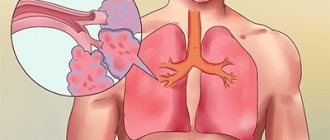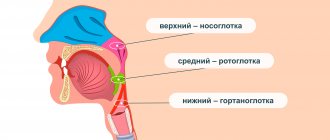About the cereal
Croup is a syndrome affecting the larynx, which is characterized by choking and barking cough with hoarseness in the voice.
Croup can develop when an inflammatory process occurs in the mucous membrane of the larynx. There is a difference between false and true croup. True croup is caused mainly by diphtheria bacilli with fibrinous inflammation of the mucous membrane of the larynx with further formation of films on its surface. True croup is characterized by a progressive increase in suffocation. False croup can be characterized by catarrhal inflammation with swelling of the mucous membrane of the larynx, which is directly related to the area of the vocal cords. False croup occurs when you have viral influenza, parainfluenza infections, measles, etc.
Character of the current
According to the nature of the course, croup is divided into uncomplicated and complicated (when other respiratory tract diseases are added to the croup). False croup (acute laryngitis) is divided according to the type of disease in the respiratory tract into the following types of laryngitis:
- edematous, when the throat becomes red and swollen. Where the folds of the tonsils are located, small gray ridges are visible that narrow the lumen of the glottis;
- hemorrhagic, when there are a lot of hemorrhages on the mucous membrane of the throat in the area of the trachea and larynx, there are edematous ridges in the subglottic area, due to which the lumen of the larynx becomes very narrow, bloody crusts;
- catarrhal-edematous – swelling of the throat is accompanied by a hoarse voice and rhinitis;
- ulcerative, when there is swelling in the subglottic area, the lumen of the larynx is very narrow and a lot of pus accumulates in it.
Symptoms of false croup
Stridor is wheezing, bubbling, and labored breathing. The stronger the swelling of the larynx, the more powerful the noises that are heard when the patient inhales and exhales. Increased noise indicates an increase in laryngeal edema and urgent medical care for the patient. A barking, dry cough may appear, as a rule, not long before stridor forms.
Hoarseness and hoarseness are obvious symptoms of croup only if there is stridor along with these symptoms. In other remaining cases, hoarseness or hoarseness are considered signs of laryngitis, which occurs without significant swelling of the larynx.
Typically, croup develops against the background of an acute respiratory viral infection, and therefore, in addition to the symptoms of false croup, the patient often experiences elevated body temperature, lethargy, pain in the muscles and joints , and other symptoms of a cold. The appearance of symptoms of false croup against the background of a typical cold should be alarming. A patient with false croup needs constant monitoring and special treatment.
Stages of laryngeal stenosis
False croup is divided not only into bacterial and viral, but also according to the degree of laryngeal stenosis:
- 1st degree – compensated stenosis (absence of shortness of breath, microcirculatory symptoms, aphonia (hoarse voice or its complete absence, respiratory exicosis);
- 2nd degree – subcompensated stenosis;
- 3rd degree - decompensated stenosis or uncompensated croup (presence of shortness of breath, laboratory symptoms of hypoxia, no expectoration, there are all the signs that are not present in compensated stenosis);
- 4th degree – croup in the terminal stage of stenosis.
False croup in children
If for adults ARVI or the so-called “common cold” goes away in a couple of days, without causing any particular trouble (except for snot, malaise and cough), then for children in particular this is a difficult disease. To be more precise, a group of diseases.
The danger lies in the addition of various complications, one of which, and the most dangerous, is false croup. False croup is also called acute stenosing laryngitis (OSL), or laryngotracheitis. It all depends on whether only the larynx or the larynx and trachea are affected.
False croup in children can sometimes recur over and over again . There is a category of children in whom laryngeal stenosis develops with any runny nose, even with the mildest form of infection. Children with increased emotionality and excitability, allergic predispositions and esudative diathesis are at risk. Boys suffer from false croup more often than girls. By the age of 6-8 years, the cereals stop - the child, simply put, “outgrows” them, since the lumen of the larynx has become wider, and its swelling is no longer life-threatening.
Symptoms of false croup in children can appear either suddenly (even in full health) or gradually, a couple of days after the onset of ARVI. The larynx swells primarily at night, but can also swell while you are awake or sleeping during the day. False croup in children can be confused to some extent with suffocation as a result of a foreign body, but in this case the child will not be able to speak. With false croup in children, speech is preserved, the voice becomes squeaky and hoarse.
Sometimes false croup in children is confused with attacks of bronchial asthma, but here it is important to know that: with false croup, inhalation is difficult with a noisy sound, and exhalation is almost inaudible. This greatly frightens parents and gives the impression that the baby is not breathing, trying to draw in air. With bronchial asthma, the opposite is true: inhalation is completely free, but exhalation is difficult, with a whistle.
DESCRIPTION OF THE INFORMATION WE COLLECT AND HOW WE USE IT
1. General information
Like many commercial organizations, we monitor use of this site by collecting aggregate information through cookies (see below). As a rule, we keep statistics on the number of visits to the site, each web page and register the name of the original domain of the Internet service provider whose services the visitor uses. The information obtained allows us to make conclusions about the use of the site by the visitor, and may also be transferred to other companies of the Group and other third parties.
2. Personal information
When you register as a user on our website or fill out an online form (for example, to receive email updates), we collect personal information about you, such as your first and last name, email address, country of residence, and other information you provide voluntarily.
We are committed to improving the content and functionality of our site. Therefore, through cookies (and other similar technologies) we collect information about your use of this site (see below). We may also monitor navigation and use of the site in order to improve its design and structure, taking into account user preferences by tailoring content. By doing this, we strive to make the site more user-friendly. We may also conduct statistical analyzes of our user accounts to determine the proportion of active users, the frequency of their visits, and the number of other sites they are registered with.
In some cases, we may receive information about your opinions, for example when you send us feedback or ask questions, as well as information about you from other publicly available sources, which we will supplement with information we already have in order to improve the service to suit your specific requirements. user.
If you provide information about another person, such as your colleague, you confirm that you are acting on the instructions of such person and provide his consent to the processing of his personal information, including important personal information, and also confirm that you have provided such person with information about us and about the purposes (in accordance with this Privacy Policy) for which personal information will be used.
We may provide personal information upon request to comply with legal requirements.
You consent to our transfer of information to countries or jurisdictions that do not provide legal protection for data protection to the same extent as your country. When we make such a transfer, we are committed to ensuring that your information is adequately protected.
All personal data provided to AstraZeneca Pharmaceuticals LLC, as well as companies included in the group (including those entered on the website), can be used and processed, in addition to the above, also for the purposes of:
• providing scientific medical and any other information about AstraZeneca products, as well as materials in written, printed, electronic, audio, video, oral and any other appropriate form, via email, regular and courier mail, telephone calls, SMS messages , messages on social networks on the Internet, in person and/or in any other appropriate way;
• invitations to scientific, educational and other events aimed at improving the professional level of relevant specialists, in all the above ways and in all the above forms;
• creating a database of persons who provided their personal data.
The person who voluntarily provided his personal data and information is notified and consents to the processing by AstraZeneca Pharmaceuticals Limited Liability Company, all other companies included in the group, as well as any third parties to whom AstraZeneca Pharmaceuticals LLC transfers the relevant personal data for the purposes specified above, and subject to the obligatory condition that these persons ensure the security of the personal data provided above, including collection, recording, systematization, accumulation, storage, clarification (updating, changing), extraction, use, transfer (distribution, provision, access, including cross-border transfer), depersonalization, blocking, deletion, destruction with or without the use of automation tools. Also, the Person who voluntarily provided his personal data and information is notified and agrees that during the cross-border transfer of his personal data, recipients of such data may be located in foreign countries that do not provide adequate protection of the rights of personal data subjects. Operators, at the same time, undertake to take all reasonable and appropriate actions to ensure the confidentiality and security of any Personal Data transferred to the territory of any foreign countries.
This consent to the processing of personal data is given for an indefinite period and can be withdrawn by sending a written application to the site administration. I hereby acknowledge and confirm that I have read and agree with the rights and obligations in accordance with the Federal Law of the Russian Federation of July 27, 2006 No. 152-FZ “On Personal Data,” including the procedure for revoking consent to the processing of personal data.
Filling out the form for providing Personal Information implies agreement that any personal data provided by filling out this form can be used, taking into account the consent provided, in accordance with the requirements of the Federal Law of the Russian Federation of July 27, 2006. No. 152-FZ “On Personal Data” and stored for ten years at (125284, Moscow, Begovaya St., 3, building 1) for registration and response to this request for scientific medical information.
Treatment of croup in children
Treatment of croup in children and acute laryngitis involves the use of certain measures. If you experience symptoms of croup, be sure to consult a doctor. When laryngitis goes away without croup, you should not call an ambulance until the child’s condition remains without signs of croup, that is, stable. Before the ambulance arrives, create a “tropical atmosphere” for the child - it is advisable to place the child in a room with high humidity (the room temperature should not exceed 18° C). If your body temperature is higher than 38.5° C, call a doctor at home.
At the ENT-Asthma clinic, leading experienced doctors will determine the type of inflammation in the larynx and prescribe a personal, best treatment regimen , which in the vast majority of cases will prevent abnormal pathological processes in the mucous membrane of the larynx.
If necessary, the doctor prescribes laser therapy for the treatment of croup, and systemic treatment is carried out on sore spots. During the recovery stage, the patient has the opportunity to attend classes to restore voice (phonopedia) and improve immunity, undergo psychogenic rehabilitation, and breathing exercises.
A comprehensive and individual approach to the treatment of croup in children, practiced at the ENT-Asthma clinic, guarantees an improvement in the well-being of young patients after treatment in a short time. As a result of treatment, the voice is restored, hoarseness, cough and sore throat are eliminated, and the development of chronic diseases of the larynx is prevented.
In adults
In adults, as mentioned above, croup is rare and has a diphtheria etymology. False croup occurs extremely rarely and has the same symptoms as in children. But with true croup, diphtheria, the patient’s body temperature rises to 38.5 degrees, the pharynx mucosa turns red, and islands of plaque appear on it - smooth and grayish-white. This plaque is difficult to remove with a spatula or a teaspoon, and if this is still possible, a bleeding wound forms in its place. The tonsils are swollen, so they practically close together.








